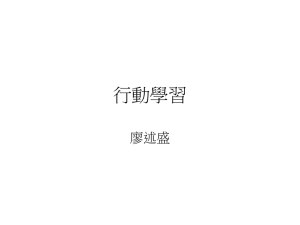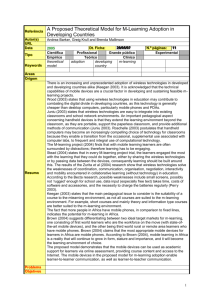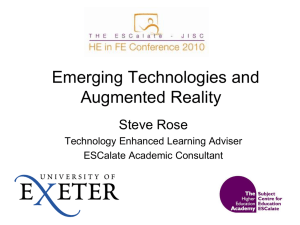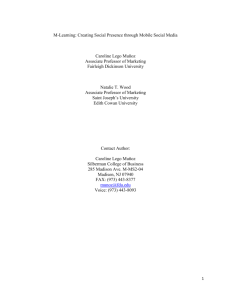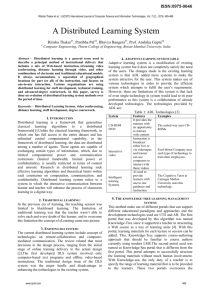M-LEARNING TO SUPPORT TEACHING EDUCATION PROGRAM IN INDONESIA Safitri Yosita Ratri
advertisement
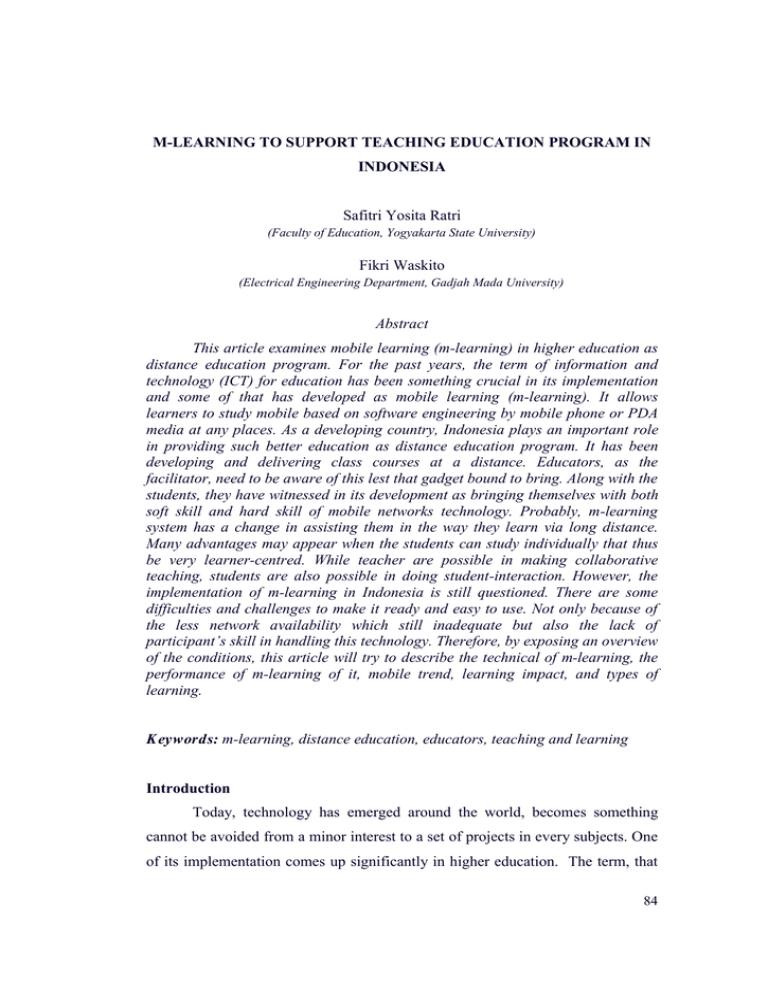
M-LEARNING TO SUPPORT TEACHING EDUCATION PROGRAM IN INDONESIA Safitri Yosita Ratri (Faculty of Education, Yogyakarta State University) Fikri Waskito (Electrical Engineering Department, Gadjah Mada University) Abstract This article examines mobile learning (m-learning) in higher education as distance education program. For the past years, the term of information and technology (ICT) for education has been something crucial in its implementation and some of that has developed as mobile learning (m-learning). It allows learners to study mobile based on software engineering by mobile phone or PDA media at any places. As a developing country, Indonesia plays an important role in providing such better education as distance education program. It has been developing and delivering class courses at a distance. Educators, as the facilitator, need to be aware of this lest that gadget bound to bring. Along with the students, they have witnessed in its development as bringing themselves with both soft skill and hard skill of mobile networks technology. Probably, m-learning system has a change in assisting them in the way they learn via long distance. Many advantages may appear when the students can study individually that thus be very learner-centred. While teacher are possible in making collaborative teaching, students are also possible in doing student-interaction. However, the implementation of m-learning in Indonesia is still questioned. There are some difficulties and challenges to make it ready and easy to use. Not only because of the less network availability which still inadequate but also the lack of participant’s skill in handling this technology. Therefore, by exposing an overview of the conditions, this article will try to describe the technical of m-learning, the performance of m-learning of it, mobile trend, learning impact, and types of learning. K eywords: m-learning, distance education, educators, teaching and learning Introduction Today, technology has emerged around the world, becomes something cannot be avoided from a minor interest to a set of projects in every subjects. One of its implementation comes up significantly in higher education. The term, that 84 called ICT has provided to support teaching and learning system into internet based way. It has employed a variety of technological platforms to support interactions between teachers and learners and among learners separated by distance, time or both (Srivastava, 2003). It has been known that distance education, or distance learning, is a field of education that focuses on the pedagogy/andragogy, technology, and instructional systems design that aim to deliver education to students who are not physically "on site". Rather than attending courses in person, teachers and students may communicate at times of their own choosing by exchanging printed or electronic media, or through technology that allows them to communicate in real time. Distance education program that require a physical on-site presence for any reason including the taking of examinations is considered to be a hybrid or blended course or program. Referred to Srivastava (2003), this is leading undoubtedly to the ascendance of distance education as a popular mode of education being adopted by both distance teaching institutions as well as conventional institutions offering campus bound face to face education. It can be said that the adoption of ICTs has opened up new fundamentally different options for higher education both in how to run the business of higher education as well as in methodologies of teaching and learning. More institutions are involved in distance education today than at any other time in history. Distance education has truly moved to the centre stage today. Learning by mobile in this country is still being developed as designing into educational content. Some reviews of m-learning will be put forward to understand globally. Corbeil (2008) stated that students and faculty who already use mobile computing and communication devices will find ways to integrate them into all aspects of their lives—including the tasks of teaching and learning. Educators can assist students by making content more readily available and in formats that are easily accessible through popular mobile devices. As these devices become more powerful, they may coexist with or supplant other technologies to make learning more portable. However, the main issue is not simply m-learning system implementation to be put into distance education 85 program in each institution. There are some notices facing its implementation. However, to make it better for distance education program process, educators must stand as underpinning to those facts. Therefore, it will be a great value to encounter some review concerning to omit some challenges in our country. Technical m-learning The mobile learning or m-learning is the learning which occurs when the student is not in a fixed location or a training which occurs when the student benefits from the opportunity offered by mobiles technologiesthe last years, due to the exponential growth of the Internet had as consequence a great usage of multimedia data in education too. As a result, the importance of the researches in multimedia (Laroussi, 2004). Nyiri (2002) described M-learning, or mobile e-learning, as essentially elearning delivered through mobile computational devices (Palms, Windows CE machines, digital cell phones, MP3 players, etc.) . So, mobile learning can provide online learners with capabilities to get instant notification by e-mail, access learning sites, report data from the field, and collaborate with learning colleagues. But m-learning is much more than simply e-learning through mobile devices; mlearning will characteristically aim at specific kinds of knowledge depending on location, situation, device, and learner. Mobile learning represents the next stage of computer-aided, multi-media based learning. Expectations are high due to nearly boundless independency of learning regarding time and space. Mobile technology, as we known, is a fast developing mobile communication technology which includes local area wireless networks by Wi-Fi, Third Generation (3G) mobile networks, and related mobile computing devices such as mobile phones, pocket PCs, Tablet PCs, and Personal Data Assistant (PDA) devices. Mobile technology provides people with “wearable” computing ability to conveniently participate in learning environments at anytime and anywhere. In this country, the users of mobile technology is blooming rapidly by the time. 86 Students can use several different types of mobile devices to access online learning environments. By incorporating mobile technologies into their learning process, willingness for future work efforts is strongly improved. Enhanced time efficiency, ready access to online course rooms, and increased opportunities for collaboration with peers is representative of the many benefits associated with mobile technology. With the use of mobile learning, distance education can incorporate students from different backgrounds with vastly diverse learning styles and different skills, included people who have a disability or specific learning difficulty. M-learning offers new opportunities for people that require mobile computer solutions that other device cannot provide. We can see mlearning is not only e-learning through mobile devices. As mobile devices evolve and people discover new ways in which the functionality of mobile devices can be applied to learning, mobile e-learning will become increasingly different from conventional e-learning and will create a new learning environment; an environment where learners can access to contents, teachers and other learners anywhere and anytime, where the contents they are accessing are dynamic and dependent on their location at space and time, and finally where learners can record any learning content to later use (Anido, 2008). Performance of m-learning Briefly, we can see M-learning as the tiny version of E-learning. M, represents Mobile, is the main difference of M-learning and E-learning. Mlearning use mobile devices in accessing the data. The mobility of the user is the main advantage of M-learning. The other advantage is the tiny size of data transfer. As we known that mobile devices can only access certain size of the data. With tiny size of data, the server does not need a huge size of storage to keep the data of M-learning. Anido (2008) quotes some important point to be given a special attention in order to maintain the M-learning, which is: User interface adaptation – Mobile device screens such as the ones found in PDAs to the ones found in smart phones are relatively much smaller compared to screens available in bulkier devices such as personal computers (PCs) and laptops. 87 This reduced screen size in mobile devices creates limitations in creating mobile device user interfaces. Mobile presentation technologies such as the Wireless Markup Language (WML) (http://www.wapforum.org) and later the Compact Hypertext Markup Language (http://www.w3.org/TR/1998/NOTEcompactHTML-9980209) (cHTML) address this limitation. User Interface restriction is one of the two main challenges presented in Pocket SCORM proposals. Pocket SCORM is a project attempting to adapt the SCORM standard to mobile devices. Memory – Whilst mobile devices are commonly associated with memory restrictions, the latest generations of mobile devices such as phone enabled PDAs are changing the situation mainly via SD chip technology. Bandwidth – Whilst bandwidth available for mobile devices has been known to be low and costly, extended WI-FI coverage (Balachandran, 2003), and the increasing popularity of PDA devices (Dearnley, 2004) are improving the situation. Asynchronous communication – Bandwidth limitations are favouring asynchronous communication within the field of mobile devices, where due to lack of WI-FI coverage or GPRS costs, mobile device user sessions are carried out off- line with the device being required to be on-line only at the stages where application server synchronization is required. Asynchronous communication is the second main challenge identified by Pocket SCORM within the field of mobile learning. The difference and fast improvement of mobile technologies among mobile devices is one of the main point that should be given a special attention. For example, the content that created for the PDA is not accessible for mobile phones because the different size of memory and screen. The sollution of this problem is by adapting the content. Adaptation by the supplier supposes to realize resource adaptation at the server level and it is realized function on the mobile terminal and/or network characteristics. The former transaction detects the characteristics. After a successful adaptation, the transmitter sends to receiver, its version of adapted 88 resource. This action need the usage of server computing power and adds a delay between the client request and resource delivery by the server. The easiest way to adapt this sollution is by designing the content based on the lowest grade of the mobile technology used in this country. Adaptation by the receiver supposes to take the decision about what and how to be adapted, at the terminal level, even if the adaptation is made in another place, in a proxy node, for example. It is not recommendable to realize the adaptation at the final user because at this place the adaptation could fail because of insufficient client resources and because of additional network bandwidth needed. Both methods can be view as nontransparent adaptation techniques because final nodes and communication protocols implied during the adaptation process. The example of this solution is using the same browser to access content (Reveiu, 2008). Mobile trend The technology and variety of mobile devices is growing rapidly in last few years. 10 years ago, the PDA-phone is rarely used in this country. But nowadays, we can see that most of people use high technology mobile devices in their daily life. PDA-phone is the most suitable device for M-learning because of the computation ability and the size of the screen. The variety of mobile devices used will affect the size and complexity of content used in M-learning. With this consideration, the trend of mobile devices in current condition will drive the technology of M-learning. Learning impact for teacher and student According to Corbeil (2007), mobile communication offers an opportunity for teacher and student to be some skill of computing in different kinds of instructional setting. This device makes them on the flexibility and freedom afforded. Yet, this benefit demand new pedagogies skill to delivering and facilitating instruction or content. Learners can provide instructional materials and interaction through their mobile devices wherever and whenever they need. 89 Once m-learning adopted by teacher and student, it will depend on how efficient and necessary they consider the services and features. If students want to be informed by short message services (SMS) every time a new message is posted on the announcement pages of their online courses, they probably subscribe if it were an option. Then, if faculty can facilitate them in online and directly respond to individual queries while travelling, many of them will be satisfied with these services. However, there are challenges and obstacles that must be overcome before educators can realize the full potential of m-learning. The most obvious obstacle is the limited memory of mobile devices (http://www.palmpowerenterprise.com). According to Palm, devices come with 2MB to 8MB of memory, though more recent models feature an SD (Secure Digital) expansion slot, allowing more memory, or even full programs, to be added. Mobile phones, meanwhile, come with almost no memory. The consequence is that today the more robust PDAs can handle a limited amount of rich content. Thinner devices can handle basic textual content. And, lastly, mobile phones are at best useful for enabling students to check test scores remotely. In addition, students download only limited amounts of content. Fortunately, most courseware is "chunked" into relatively small learning objects that make it practical to download only a minimal amount of content at a time. In the future, the devices will be more robust. We'll see more prevalent use of intelligent networks that can detect the kind of device the learner is using and how much memory they have and then transmit the appropriate amount of content. Types of learning M-learning for universities makes the possibilities in exploring handheld learning. Groups of students will be accustomed to using this system to disseminate course-work, post e-portfolios, and facilitate discussions with tutors. While between students can access material everywhere and every time by interaction, teacher also can access services and interact with students while on the move. M-learning allows educators to shift from being transmitters of 90 knowledge to facilitator of learning in order to create new learning pathways that more situated, personal, and collaborative. Naismith (in Corbeil, 2007) offered the following suggestion for adapting m-learning to the six major types of learning: - Behaviourism: quick feedback or reinforcement can be through mobile devices. - Constructivism: mobile devices enable immersive experiences such as those provided by simulations or games. - Collaborative learning: mobile devices provide a handy additional means of communication and a portable means of electronic information gathering and sharing. - Informal/lifelong learning: mobile devices accompany users in their everyday experiences and become a convenient source of information or means of communication that assist with learning. - Support/coordination: mobile devices provide just-in-time access to learning resources, news, information, planners, address book, calculator, and so forth. Using portable computing devices (such as laptops, tablet PCs, PDAs, and smart phones) with wireless networks enables mobility and mobile learning, allowing teaching and learning to extend to spaces beyond the traditional classroom. Within the classroom, mobile learning gives instructors and learners increased flexibility and new opportunities for interaction. Mobile technologies support learning experiences that are collaborative, accessible, and integrated with the world beyond the classroom (http://www.educause.edu). With m-learning assistance, it will help educators combine best pedagogic practice with some advanced software tools to make m-learning work better. Summary · It should be prepared to take advantage of their benefits in higher education by planning how best to employ mobile devices in online and traditional classes. 91 · M-learning has an opportunity to become important in implementing effective teaching and learning for distance education program by supporting learner’s needs, accessibility, and availability of technology. · M-learning is mobile and tiny version of E-learning. · M-learning is supported by great number of high-technology mobile devices in this country. · M-learning is a simple technology as long as the content adaptation is given a special attention. Device independence and support for accessibility are essential for mobile learning. · There are some types of effective learning supported by mobile devices such as behaviourism, constructivism, situated learning, collaborative learning, informal/lifelong learning, and support/coordination. Reference Balachandran A., Voelker G. M. and Bahl P., “Wireless Hotspots: Current Challenges and Future Directions,” in Proceeding of WMASH’03, September 2003. L. Anido-Rifon, “Accessibility and Supporting Technologies in M-Learning Standardization”, Proceedings of the IEEE Third International Conference on Systems (2008) Dearnley J.A., McKnight C. and Morris, A. Electronic Book Usage in Public Libraries: A Study of User and Staff Reactions to a PDA-Based Collection. Journal of Librarianship and Information Science. 36(4), December 2004, pp. 175-182. Laroussi M., Derycke A., New e-learning services based on mobile and ubiquitous computing, CALIE’04, Grenoble France, 2004. K. Nyíri, “Towards a Philosophy of M-Learning”, Proceedings of the IEEE International Workshop on Wireless and Mobile Technologies in Education (WMTE’02) Reveiu A., Smeureanu I., Dardala M., “Content Adaptation in Mobile Multimedia System for M-Learning”, Proceedings of the IEEE &th International Conference on Mobile Business. http://tojde.anadolu.edu.tr/tojde12/abs/reddy_abs.htm 92 http://connect.educause.edu/Library/EDUCAUSE+Quarterly/AreYouReadyforMo bileLearn/40029 http://www.palmpowerenterprise.com http://www.educause.edu/ELI/LearningTechnologies/MLearningandMobility/123 97?time=1232845382 93

